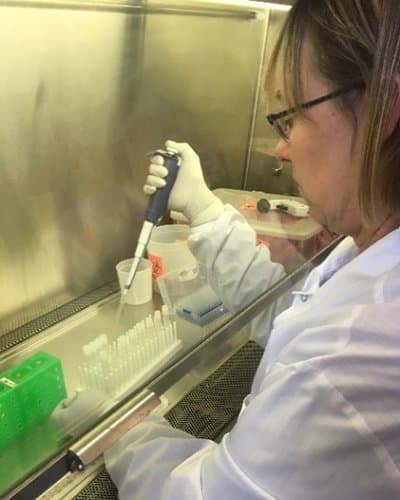Zika Virus Vaccine Looks Promising To Prevent Mother-to-Fetus Transmission
In 2015 and 2016, the Zika virus outbreak in South America surprised the global community. In pregnant women, the virus led to a high rate of fetal abnormalities, collectively called congenital Zika syndrome. Babies suffered from such birth defects as microcephaly, which is characterized by a small head and an incompletely developed brain. Although the peak of the outbreak has passed, the risk of another outbreak remains because transmission occurs primarily via infected mosquitos. In many parts of South America and Latin America, high infection rates have led to immunity among communities. No such herd immunity, however, exists in parts of the United States and elsewhere.
Dr. Koen Van Rompay, a research virologist at the California National Primate Research Center (CNPRC), has been working on a promising Zika virus vaccine—the first to show efficacy—with the ultimate goal of preventing another outbreak. Despite the urgency of the current COVID-19 pandemic, “We do not want to lose focus on developing non-COVID-19 vaccines,” Dr. Van Rompay stated.
The CNPRC is one of seven National Primate Research Centers (NPRCs) funded by the National Institutes of Health (NIH) Office of Research Infrastructure Programs. The CNPRC’s focus is broad, with multiple research units, such as the respiratory disease and reproductive disease units. Dr. Van Rompay works in the CNPRC’s infectious disease unit. His work during the past three decades had focused primarily on HIV research until the Zika virus emerged. The NPRCs began to collaborate through a newly established Zika virus working group, and Dr. Van Rompay became involved. The open platform to share ideas and experiences—both successes and lessons learned—made an important difference in the development of the Zika virus vaccine. “In the HIV research field 30 years ago, people were trying to hide their data as much as possible until they were ready to actually publish them,” said Dr. Van Rompay. “The new generation of scientists realizes, especially when we have emerging diseases, that it is important to be able to communicate. It allows us to make progress so much faster.”
Development of the VRC5283 Zika Virus Vaccine

Still, vaccine development is a long process because researchers must make sure the vaccine produces the proper immune responses and is safe. The Zika virus vaccine that Dr. Van Rompay has been working on, identified as VRC5283, initially was developed several years ago by the laboratories of Drs. Barney Graham and Theodore Pierson of NIH’s National Institute of Allergy and Infectious Diseases.
Scientists at CNPRC worked diligently to develop a nonhuman primate (NHP) model for the Zika virus. NHPs, particularly rhesus macaques (Figure 1), serve as a valuable model in large part because they resemble humans quite closely. Use of rodent models to study the Zika virus is valuable to an extent, but their fetal development is significantly different from that of NHPs. Rhesus macaques are a useful animal model for the Zika virus because affected fetuses experience changes in brain development and, as is observed in humans, are at increased risk of fetal death.1 Although the changes in macaque fetuses are not identical to those that occur in affected human fetuses, they are sufficiently similar to be of value during vaccine development and testing.
Studies of the VRC5283 Zika virus vaccine first were conducted in nonpregnant NHPs, and the success of these studies demonstrated that the vaccine could move to Phase 1 human clinical trials. In the Phase 1 trials, the vaccine induced good immune responses, and it has since advanced to Phase 2 human trials. However, the question still remains whether the vaccine is effective against the transmission of the virus from mother to fetus.
To investigate this question, Dr. Van Rompay and his colleagues began by administering the vaccine to nonpregnant female macaques and attempting to breed them so that some became pregnant. The females that became pregnant were exposed to the Zika virus at three time points—at 30, 60, and 90 days of gestation to mimic exposures during a human’s first and second trimesters. The duration of a rhesus macaque pregnancy is approximately 165 days, or about 5 months. The scientists then studied the outcomes in the mother and fetus (Figure 2).

The vaccine demonstrated major benefits.2 First, vaccinated pregnant females, after exposure to the virus, showed lower virus replication in the blood than the control animals. Second, the amount of virus detected negatively correlated with the amount of neutralizing antibodies the animals had at the time of first exposure to the virus. The more neutralizing antibodies the mothers had, the less virus replication was detected, and above a certain threshold of neutralizing antibodies, no virus was detected.
Additionally, the researchers harvested fetal tissues to study the effect of the vaccine on fetal development. Of the 12 control fetuses whose mothers did not receive the vaccine, 11 showed evidence of the virus in their tissues. In contrast, none of the 13 fetuses whose mothers received the vaccine prior to conception showed evidence of the virus in their tissues. This finding demonstrates that the vaccine is effective in reducing transmission of the virus from mother to fetus.
“This shows that the vaccine has very good efficacy and is highly promising,” states Dr. Van Rompay. “This really is a good incentive to move forward with Zika vaccine development, whether it is this vaccine or another Zika vaccine. It shows proof of concept that it should be possible to develop and bring a Zika vaccine to market that can reduce the risk of congenital Zika syndrome for Zika-infected pregnant women.”
A different study conducted by Dr. Van Rompay and his colleagues at The Rockefeller University showed that preventive administration of two monoclonal antibodies to pregnant macaques partially protected against fetal brain damage and limited transmission of the Zika virus from mother to fetus.3 Administering such antibodies could be an effective way to convey rapid protection against the virus at the onset of an outbreak, before a vaccine is able to be deployed.
The Need for Therapeutics
A major need still exists to develop therapeutics to give individuals who already are infected. “What would you do if a pregnant woman becomes infected and shows symptoms?” Dr. Van Rompay considered. “Perhaps she already has transmitted the virus to her fetus.” Dr. Van Rompay is interested in studying antiviral drugs, particularly those that would cross the placenta and reach the fetus without having harmful effects on its development. Some companies have been working on this effort, but given the current COVID-19 pandemic, Zika currently is not a top priority.
“The NIH is fully aware that animals are a very valuable resource,” added Dr. Van Rompay. “Not everything can be studied in vitro or using computer models.” He highlighted the importance of animal research and the need for continued investment in NHPs, NPRCs, and the education and training of the next generation of scientists.
References
1 Dudley DM, Van Rompay KK, Coffey LL, Ardeshir A, Keesler RI, Bliss-Moreau E, et al. Miscarriage and stillbirth following maternal Zika virus infection in nonhuman primates. Nature Medicine 2020;24:1104–7. doi: 10.1038/s41591-018-0088-5.
2 Van Rompay KKA, Keesler RI, Ardeshir A, Watanabe J, Usachenko J, Singapuri A, et al. DNA vaccination before conception protects Zika virus–exposed pregnant macaques against prolonged viremia and improves fetal outcomes. Science Translational Medicine 2019;11(523):eaay2736. doi: 10.1126/scitranslmed.aay2736.
3 Van Rompay KKA, Coffey LL, Kapoor T, Gazumyan A, Keesler RI, Jurado A, et al. A combination of two human monoclonal antibodies limits fetal damage by Zika virus in macaques. Proceedings of the National Academy of Sciences 2020;117(14)7981–9. doi: 10.1073/pnas.2000414117.



